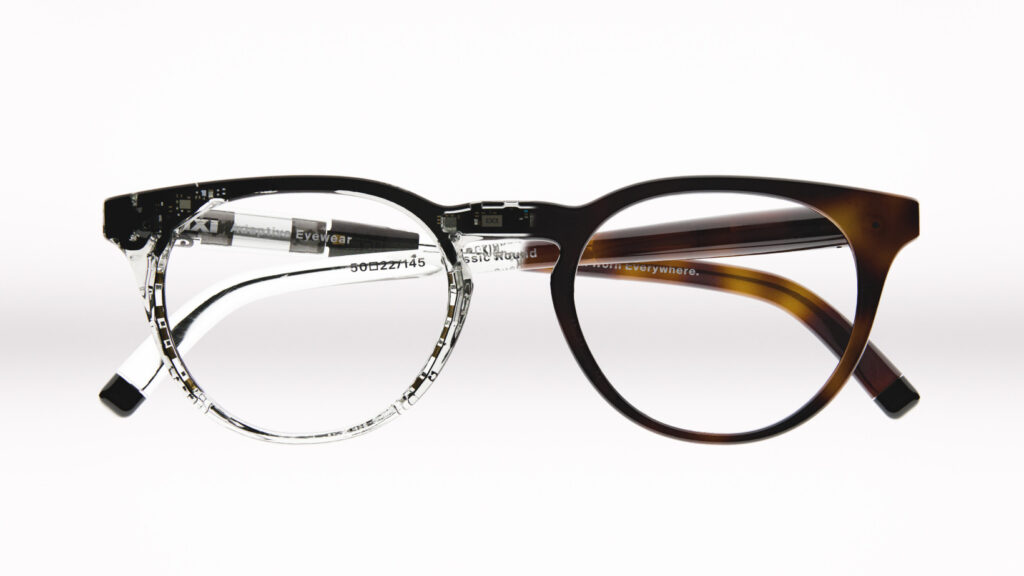A new entrant in vision tech wants to change how presbyopia is corrected: automatically.
While tech giants chase the next smart wearable, Finnish startup IXI (Helsinki, Finland) is quietly tackling the more fundamental problem of vision correction.
Backed by $36 million in funding, IXI has unveiled a prototype of what it calls the world’s first autofocus prescription glasses.
The device is designed not for AR or selfies, but for real-time, personalized vision correction. Instead of progressive lenses or bifocals, IXI’s adaptive eyewear would use low-power sensors and liquid crystal optics to adjust focal length based on where the wearer is looking.
READ MORE: Solos Launches First Smart Glasses with GPT-4o Integration
Dynamic focus
IXI’s solution pairs its liquid crystal optics with a proprietary eye-tracking sensor. Low-energy light pulses detect where the user is looking and at what distance, triggering a subtle shift in optical power.
The lens is a layered stack of liquid crystal that adjusts focus dynamically based on electrical input. The shift takes about 0.2 seconds, which is quick enough to feel natural without the visual lag that plagues many adaptive devices.

“We’re trying to push the same step change that happened with cameras—from fixed focus to manual focus to autofocus,” said founder and CEO, Niko Eiden in an interview with TNW.
The tech is all tucked into a frame that looks remarkably unremarkable. But that’s exactly the point.
READ MORE: The Future of Eyewear
Mini tech, major hurdles
Early prototypes seek to preserve the familiar form factor of everyday eyewear. Drawing on talent from Nokia and Varjo, the team has focused on wearable, low-profile hardware that won’t stand out in a crowd, an unconventional approach in a world dominated by loud innovation—and one that the designers hope pays off when it comes to adoption.
Despite the early buzz, IXI’s glasses are still in the prototype phase, and several engineering puzzles remain. The sensors and drivers must fit within the dimensions of a regular frame and the lenses must maintain transparency, responsiveness and long-term comfort.
One of the core technical hurdles has been miniaturization. The eye-tracking sensors and lens-shifting components must all fit within the slim silhouette of a standard eyeglass frame. To meet this demand, IXI has developed its own manufacturing processes, including precision laser-based fabrication.
The company’s current prototypes still rely on external components to process visual data, though plans are in place to integrate everything into the frame. Each pair is calibrated to the user’s eyes using a mobile app, which tailors performance to individual focal habits.
READ MORE: A Global Crisis in Basic Eye Care: Millions Still Struggling Without Glasses
From squinting to solutions
Presbyopia is a universal consequence of aging, and myopia is becoming a global epidemic. By 2050, nearly half of the world’s population is projected to be myopic.1 That’s a lot of squinting.
Meanwhile, the eyewear industry continues to rely on bifocals and progressive lenses that have changed little over the decades. While functional, these lenses often introduce narrow viewing zones, peripheral distortion and the dreaded “image jumps” that require wearers to adjust their behavior to the optics rather than the other way around.
With its autofocus technology, IXI has taken a decidedly different route. Instead of segmenting visual correction into fixed zones, the company is building a dynamic lens that adjusts focus in real time, aiming to restore a more continuous and intuitive visual experience. And they aren’t alone in this endeavor.
Not alone in the optical arms race
While IXI has been the most public in its vision for adaptive prescription eyewear, it is not alone in the race. Laclarée (France) and Elcyo (Japan) are also developing autofocus prescription glasses, though neither has launched a product.
What makes IXI’s approach distinct is its singular focus on corrective vision, not notifications or digital overlays. In a world enamored with smartglasses, IXI is betting on simple, smart optics.
The global eyewear market reached $200 billion in 2024 and continues to grow. With presbyopia affecting nearly everyone over 45, and high myopia on the rise, there’s no shortage of potential users. If IXI’s tech delivers on its promise, it could offer an alternative for those who find progressive lenses limiting or contact lenses uncomfortable.
READ MORE: Eyeglasses in the Age of Virtual Reality
A shifting lens on refractive care
If autofocus eyewear succeeds in matching the clarity and comfort of conventional lenses, it could offer a new model for managing presbyopia, high myopia and other age-related refractive changes, particularly for patients who struggle with progressives or multifocal contact lenses.
Autofocus eyewear isn’t about strapping a smartphone to your face. It’s about restoring visual fluidity, something static lenses have long interrupted. The prototype stage may still come with hurdles, but the goal is autofocus glasses that adjust like a healthy eye, which could redefine everyday vision correction and potentially retire the reading glasses once and for all.
Editor’s Note: This content is intended exclusively for healthcare professionals. It is not intended for the general public. Products or therapies discussed may not be registered or approved in all jurisdictions, including Singapore.
Reference
- Holden BA, et al. Global prevalence of myopia and high myopia and temporal trends from 2000 through 2050. Ophthalmology. 2016;123(5):1036–1042.
